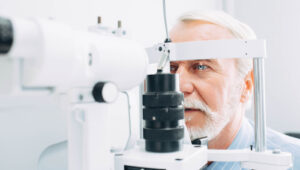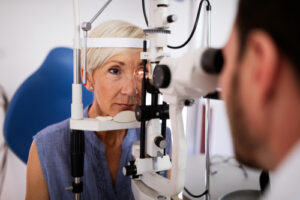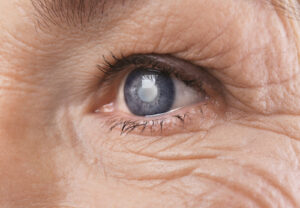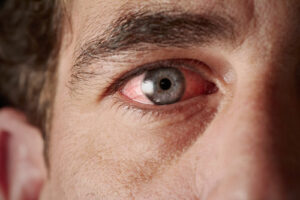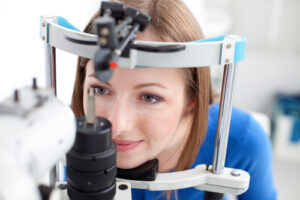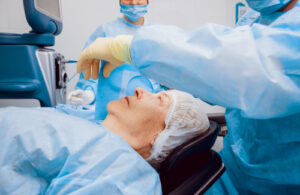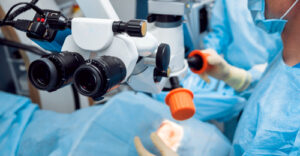Do words on the menu or your phone look blurry? Has it become increasingly difficult to see?
You might have a cataract. Cataracts are typically not noticeable at first, but you may start to experience symptoms like blurred, cloudy vision and poor night vision as the cataract grows.
Some of the symptoms of a cataract can be the same as those of presbyopia, so they can be hard to diagnose on your own. Keep reading to learn more about cataracts, including seven signs you may be experiencing cataracts instead of presbyopia!
What Is the Difference Between Presbyopia and Cataracts?
You can have presbyopia and cataracts at the same time. However, they’re completely different eye conditions.
What is Presbyopia?
Presbyopia happens when your eye lens becomes less flexible as you grow older. So, how does that affect your vision?

Your lens allows you to focus. It changes shape to provide clear, up-close vision.
But with age, the lens loses its flexibility. When your lens is rigid, it can’t change its shape the same way.
Consequently, it becomes difficult to focus on close-up objects. Most people start to notice the effects of presbyopia at around age forty.
Common symptoms of presbyopia include:
- Squinting
- Difficulty reading small print
- Trouble focusing on near objects
- Eye fatigue from doing close activities
- Needing brighter lighting for up-close work
- Headaches or eyestrain after reading or performing close work
- Holding reading materials at arms-length to make words clearer
What is a Cataract?
Like presbyopia, a cataract also affects your lens. But cataracts occur when proteins in your eye break down and clump on your lens, causing it to become cloudy.
Most cataracts grow gradually and won’t disturb your vision in the early stages. You may not even realize you have a cataract until it’s more advanced.
Over time, cataracts lead to poor vision and may eventually cause blindness. But any vision lost to cataracts can be regained through cataract surgery.

Cataracts may form in one or both eyes. When they’re in both eyes, they often develop at different rates.
What Are the Most Common Signs of Cataracts?
You may have a cataract if you are experiencing any of the following symptoms:
1. Blurry Vision
Does your eyesight become blurry when reading a text or looking at an object? It could be a sign of a cataract.
Blurred, filmy, or cloudy vision is one of the most common symptoms of cataracts. As a cataract becomes bigger and more opaque, it blocks light entering your eye, causing blurry vision.
It may feel like you’re looking at the world through a foggy window when you have cataracts. With time, your vision might become blurry, making watching TV, driving, and performing other routine activities increasingly difficult.
2. Sensitivity to Light
You may experience light sensitivity when you have a cataract. A clear lens lets light pass easily through it.
The lens then works together with your cornea to focus light properly onto the back of your eye or retina. But when you have a cataract, the cloudy lens scatters light and prevents it from focusing correctly on the retina.
This can cause light sensitivity. As a result, bright lights and the sun might cause eye pain or make you squint or close your eyes.

3. Frequent Prescription Changes
Rapidly changing vision is a tell-tale sign of cataracts. As your cataract worsens, you’ll find that you need a stronger prescription often.
A different strength of glasses or contact lenses can improve your eyesight, but it’s only a temporary fix. Eventually, you’ll need cataract surgery to restore clear vision.
4. Needing Brighter Lighting to See Clearly
If you require more light to read a book or brighten your phone screen to see images more clearly, you may have cataracts. When a cataract darkens your lens, brighter lighting can help you see clearly for a while.
Once this stops working, your eye doctor may recommend cataract surgery.
5. Halos and Glare
You may have cataracts if you’ve noticed increased glare from lights and halos around light sources. The presence of a cataract can lead to diffraction of light entering your eye, resulting in halos and glare.
6. Poor Night Vision
Patients with cataracts often complain of worsening nighttime vision. Cataracts tend to darken or dim your vision as they progress.

These changes may not be apparent during the day when there’s sufficient natural light to compensate for your declining vision. However, dimming vision becomes more evident at night.
Combined, dim vision, halos, and glare can make nighttime driving dangerous to you and other road users. Seeing halos around streetlights and street signs while driving can be bothersome and distracting. Glare from oncoming headlights may become blinding.
If you’re having trouble with your night vision, it’s important to stop driving at night and inform your eye doctor.
7. Colors Appearing Faded
Cataracts can make colors appear washed out, dull, or faded. Cataracts will turn brown or yellow as they mature.
This discoloration is passed onto your vision, causing objects to take on a yellowish or brownish hue. As a result, it may become hard to tell certain colors apart, like blue, purple, and green, or black, navy blue, and brown.
If you often disagree with family and friends about the color of a shirt or dress, it’s time to see your eye doctor.
Get to the Bottom of Your Symptoms
The only way to know for sure if you have cataracts or presbyopia is to see the experienced doctors at Sierra Nevada Eye Center. If you have a cataract, our doctors will monitor it and let you know when it’s the right time for surgery.
Do you have signs of cataracts? Schedule your cataract screening at Sierra Nevada Eye Center in Reno, NV, today for an accurate diagnosis and proper management.











